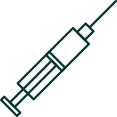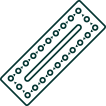
Did you know there are over 50 registered
contraceptive options available in Australia? WOW!
We’re so happy to see you here! We understand you’ve come here looking for information about… contraception!
Within the walls of this website you’ll find out about the different types of contraceptive options available in Australia, discover the science behind the menstrual cycle and learn how to spot the fake news when it comes to your downstairs area! Most importantly we have some handy tips for you to get the most out of conversations with your GP when it comes to finding the right contraceptive option for you. After all, it takes two to get the best out of life!
Let’s go!

Which contraceptive are you?
CLICK HERE TO TAKE OUR QUIZ
and find out what contraceptive best suits you and your needs!
Your contraceptive options in Australia are:
Condom (Male)

A single-use sheath or covering that fits over an erect penis. Mostly made from latex but can be made from other materials for people with a latex allergy.¹
WORKS BY forming a barrier that keeps sperm out of the vagina so it cannot meet an egg. Also protects against sexually transmitted infections (STIs).¹
EFFICACY:²
Typical use: 88%
Perfect use: 98%
Condom (Female)

A single-use sheath or lining that fits loosely inside the vagina. Has flexible rings at both ends, one at the closed end to help insertion, one at the open end to sit outside of the vagina.¹
WORKS BY forming a barrier that keeps sperm out of the vagina so it cannot meet an egg. Also protects against sexually transmitted infections (STIs).¹
EFFICACY:²
Typical use: 79%
Perfect use: 95%
Diaphragm

A soft cup that covers the cervix. The rim contains a firm, flexible spring that keeps the diaphragm in place. Should be fitted by a doctor or nurse before first use.¹
WORKS BY blocking sperm from entering the cervix so it cannot meet an egg.¹
EFFICACY:²
Typical use: 82%
Perfect use: 86%
Fertility awareness

WORKS BY relying on knowledge of the most fertile time in your cycle and avoiding sex during this time.¹
EFFICACY:²
Typical use: 76–93%
Perfect use: 95–99.5%
Pulling out

WORKS BY removing the penis from the vagina before ejaculating, instead ejaculating outside of the vagina.¹
EFFICACY:²
Typical use: 80%
Perfect use: 95%
Lactation amenorrhea (LAM)

The use of breastfeeding as contraception.⁵
WORKS BY reducing the probability of ovulation while you are breastfeeding.⁵
EFFICACY:⁵
98% as long as three criteria
are met:
• Periods have not come back
• Gave birth <6 months ago
• Fully breastfeeding (no formula)
Contraceptive injection

A progesterone-only contraceptive given as an injection into the muscle.³
WORKS BY suppressing ovulation and thickening cervical mucus.³ Frequency of injection is once evry 12 weeks.³
EFFICACY:²
Typical use: 96%
Perfect use: 99.8%
Vaginal ring

A soft plastic ring which is inserted into the vagina where it slowly releases low doses of oestrogen and a progestogen. Can stay inside for up to three weeks.¹
WORKS BY suppressing ovulation.¹
EFFICACY:²
Typical use: 93%
Perfect use: 99.5%
Combined oral contraceptive (‘the pill’)

A pill that you take every day which contains two hormones; a progestogen and an oestrogen.¹
WORKS BY preventing the release of an egg, making the uterus an uninviting place for embryos and thickening the cervical mucus to slow down sperm.⁴
EFFICACY:²
Typical use: 93%
Perfect use: 99.5%
Progestogen only pill (‘Mini Pill’)

A pill that contains a low dose of a progestogen, sometimes called the ‘mini pill’.¹
WORKS BY thickening the cervical mucus to slow down sperm and making the uterus an uninviting place for an embryo.⁴
EFFICACY:²
Typical use: 93%
Perfect use: 99.5%
Contraceptive implant

A small plastic rod inserted under the skin of the upper arm about the size of a matchstick that releases a progestogen slowly over a three year period.⁵
WORKS BY suppressing ovulation, thickening the cervical mucus to slow down sperm and making the uterus an uninviting place for an embryo.4
EFFICACY:²
99.95% (lasts up to three years)
Hormonal IUD

A small, T-shaped plastic device that is inserted into the uterus by a trained doctor and steadily releases a progestogen over five years.¹,⁵
WORKS BY acting locally on the lining of the uterus to prevent implantation of fertilized eggs, also thickens the cervical mucus to slow sperm down and in some women suppresses ovulation.⁴
EFFICACY:²
99.9% (lasts up to five years)
Copper IUD

A small, flexible plastic and copper device which must be inserted into the uterus by a trained doctor.1 Contains no hormones.¹
WORKS BY stopping the sperm from reaching the egg and stopping any fertilized egg from sticking to the wall of the uterus.⁵
EFFICACY:²
99.5% (lasts 5–10 years)
Tubal surgery

Known as tubal ligation, works by getting an operation that blocks the fallopian tubes to stop eggs getting into the uterus.⁵
EFFICACY:²
99.5% (intended to be permanent)
Vasectomy

WORKS BY getting an operation to cut or block the tube that carries sperm out of the penis so no sperm will enter the semen.¹
EFFICACY:²
99.5% (intended to be permanent)
Blame it on the hormones
They cop the blame for so much, poor things. But which ones are important in modern
contraceptives? What do they do and how do you know what is right for you?
FIND OUT MORE
Spot the fake news!
Can you spot fake news? What about if it relates to your body?
After all, we are each an expert in our own skin. Arm yourself with the facts here.
FIND OUT MORE

It takes two…
To do the horizontal folkdance. It also takes two to have a conversation about contraception. Find out more about
talking to your GP about your contraceptive needs, and tips for how you can help them see your point of view here.
FIND OUT MORE
References: 1. World Health Organization Department of Reproductive Health and Research (WHO/RHR) and Johns Hopkins Bloomberg School of Public Health/Center for Communication Programs (CCP), Knowledge for Health Project. Family Planning: A Global Handbook for Providers (2018 update). 2. Family Planning Alliance Australia, ‘How effective is my contraceptive method?’ factsheet. March 2019. 3. Therapeutic Guidelines, Depot medroxyprogesterone contraception. Available from. https://www.tg.org.au/ (accessed March 2021). 4. Australian Medicines Handbook, Drugs for contraception. Available from: https://amhonline.amh.net.au/ (accessed March 2021). 5. Family Planning NSW, Contraception choices factsheet. Available from: https://www.fpnsw.org.au/health-information/individuals/contraception/contraception-choices (accessed March 2021).
